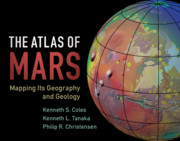Book contents
- The Atlas of Mars
- Additional material
- The Atlas of Mars
- Copyright page
- Table of Contents
- Preface
- Acknowledgments
- Abbreviations
- How to Use this Atlas
- Sources of Images
- Chapter 1 Introduction
- Chapter 2 History of Exploration of Mars
- Chapter 3 Global Character of Mars
- Chapter 4 Regional Geographic Features and Surface Views of Mars
- Chapter 5 Geology of Mars
- Map Sheets
- Mare Boreum (MC-1)
- Diacria (MC-2)
- Arcadia (MC-3)
- Mare Acidalium (MC-4)
- Ismenius Lacus (MC-5)
- Casius (MC-6)
- Cebrenia (MC-7)
- Amazonis (MC-8)
- Tharsis (MC-9)
- Lunae Palus (MC-10)
- Oxia Palus (MC-11)
- Arabia (MC-12)
- Syrtis Major (MC-13)
- Amenthes (MC-14)
- Elysium (MC-15)
- Memnonia (MC-16)
- Phoenicis Lacus (MC-17)
- Coprates (MC-18)
- Margaritifer Sinus (MC-19)
- Sinus Sabaeus (MC-20)
- Iapygia (MC-21)
- Mare Tyrrhenum (MC-22)
- Aeolis (MC-23)
- Phaethontis (MC-24)
- Thaumasia (MC-25)
- Argyre (MC-26)
- Noachis (MC-27)
- Hellas (MC-28)
- Eridania (MC-29)
- Mare Australe (MC-30)
- Moons: Phobos and Deimos
- Appendix
- Gazetteer
- References
- Index
Mare Australe (MC-30)
from Map Sheets
Published online by Cambridge University Press: 16 August 2019
- The Atlas of Mars
- Additional material
- The Atlas of Mars
- Copyright page
- Table of Contents
- Preface
- Acknowledgments
- Abbreviations
- How to Use this Atlas
- Sources of Images
- Chapter 1 Introduction
- Chapter 2 History of Exploration of Mars
- Chapter 3 Global Character of Mars
- Chapter 4 Regional Geographic Features and Surface Views of Mars
- Chapter 5 Geology of Mars
- Map Sheets
- Mare Boreum (MC-1)
- Diacria (MC-2)
- Arcadia (MC-3)
- Mare Acidalium (MC-4)
- Ismenius Lacus (MC-5)
- Casius (MC-6)
- Cebrenia (MC-7)
- Amazonis (MC-8)
- Tharsis (MC-9)
- Lunae Palus (MC-10)
- Oxia Palus (MC-11)
- Arabia (MC-12)
- Syrtis Major (MC-13)
- Amenthes (MC-14)
- Elysium (MC-15)
- Memnonia (MC-16)
- Phoenicis Lacus (MC-17)
- Coprates (MC-18)
- Margaritifer Sinus (MC-19)
- Sinus Sabaeus (MC-20)
- Iapygia (MC-21)
- Mare Tyrrhenum (MC-22)
- Aeolis (MC-23)
- Phaethontis (MC-24)
- Thaumasia (MC-25)
- Argyre (MC-26)
- Noachis (MC-27)
- Hellas (MC-28)
- Eridania (MC-29)
- Mare Australe (MC-30)
- Moons: Phobos and Deimos
- Appendix
- Gazetteer
- References
- Index
Summary
The Mare Australe quadrangle is dominated by the south polar plateau, Planum Australe (Figure 30.A), rising to about 4,800 m in elevation on its highest part, Australe Mensa (Figure 30.B). Planum Australe is roughly circular, with horizontal dimensions of 1,100 km by 1,400 km. The plateau is dissected by the large troughs Chasma Australe, Promethei Chasma, and Ultimum Chasma, which divide parts of the plateau into the tongue-shaped forms of Australe Lingula and Promethei Lingula. Also present are systems of lower relief, concentrically and obliquely trending troughs, and asymmetric ridges (Figure 30.A). The surrounding cratered highlands lie at 1–3-km elevations and include some rather exotic terrains, unique to the south polar region. Cavi Angusti form depressions tens of kilometers across and reaching depths of a kilometer. Branching ridges form Dorsa Argentea and other ridge systems that cover Argentea, Promethei, and Parva Plana, surrounding Planum Australe.
- Type
- Chapter
- Information
- The Atlas of MarsMapping its Geography and Geology, pp. 234 - 243Publisher: Cambridge University PressPrint publication year: 2019

